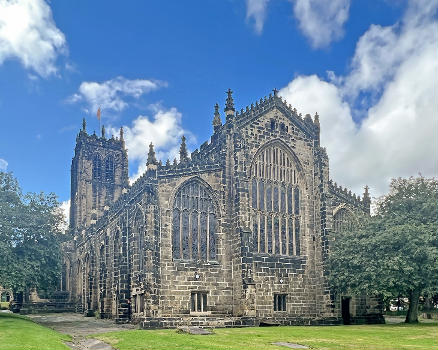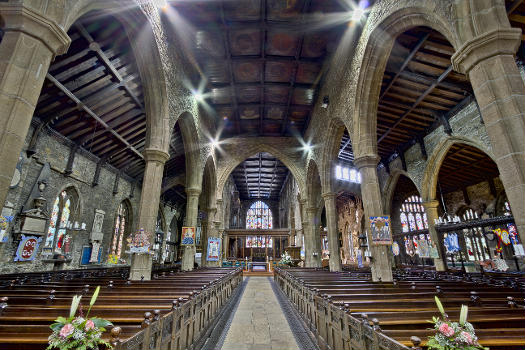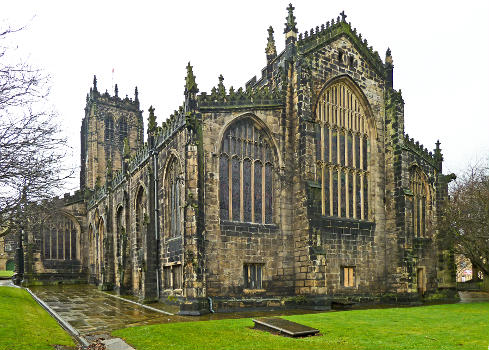General Information
| Beginning of works: | 15th century |
|---|---|
| Completion: | 16th century |
| Status: | in use |
Project Type
| Function / usage: |
Church |
|---|---|
| Material: |
Masonry structure |
Awards and Distinctions
| 1954 |
for registered users |
|---|
Location
| Location: |
Halifax, West Yorkshire, Yorkshire and the Humber, England, United Kingdom |
|---|---|
| Coordinates: | 53° 43' 23.52" N 1° 51' 13.36" W |
Technical Information
Materials
| roof |
timber
|
|---|---|
| tower |
masonry
|
| walls |
masonry
|
Excerpt from Wikipedia
Halifax Minster in Halifax, West Yorkshire, England, is dedicated to St John the Baptist; three West Yorkshire minsters are at Dewsbury (1993), Halifax (2009) and Leeds (2012).
A brief history
There has certainly been a church at Halifax for about 900 years. The Minster, formerly a Parish Church until 23 November 2009, was completed by about 1438. It comprises a nave, chancel and full-length aisles, and is thought to be the third church on this site, but it includes stonework from earlier periods. There are a few carved chevron stones, which date from before 1150, and several 12th-century tomb-covers in the porch. Windows of the Early English style in the north wall are replacements of originals dating from the 14th century. A portion of this north wall is much earlier, and may have originally been part of the Norman church; it has sometimes been claimed this was the south wall of an older church.
After the completion of the present nave and chancel, several additions were made. The tower was erected between 1449 and 1482; and the Rokeby and Holdsworth Chapels – originally chantry chapels – were completed by about 1535.
Jacobean box pews are a prominent feature of the Minster, and most of those in the nave date from 1633 to 1635. They bear some similarity to those at Bolton Percy, and the names of the carpenters involved are known. A pew in the centre aisle bears the remains of a memorial brass to John Waterhouse, who died in 1539/40. The carved arms of Richard Sunderland of High Sunderland, who died in 1634, are attached to another pew. Several ancient pew nameplates may be seen attached to a board on the inner north wall of the tower, the oldest dates to 1615 and reads “This stall made at the cost of Robert Fisher of Halifax.”
A small portion of Medieval stained-glass survives in the upper westernmost clerestory window, which was removed from other windows in the mid 19th century. The Puritans who were prominent in the town in the 17th century, thought stained glass with its ‘images’ was an abomination. During the Commonwealth (1649–1660) many plain-glass leaded windows of a unique design were installed, paid for by Mrs Dorothy Waterhouse. Many of these were later replaced by Victorian stained glass, but those that survived in 1958 were carefully rebuilt. At that date there were three of these on each side of the chancel, but now there are five on the south side and only one on the north. The large west window in the tower is a late 19th-century reconstruction of a Commonwealth window dating from 1657, but contains no original work. The great east window of the church depicts the Crucifixion and Resurrection of Jesus, and was completed in 1854. It is the work of George Hedgeland (1825–98), who exhibited stained glass at the Great Exhibition of 1851. The remaining glass in the Parish Church dates also from the Victorian and Edwardian periods.
Features
- The Font Cover is a fine feature surviving from the medieval period, and is acknowledged to be one of the finest in England. The stone font bowl may also date from the fifteenth century, or earlier. Before 1879 traces of paint could be seen on both font and cover, and it was once most ornately gilded. The cover was originally intended to prevent people from stealing the baptismal water kept in the font, which was supposed to have curative powers.
- The wooden sedilia date in the sanctuary dates from 15th century, and was restored in 1879. It contains three fine misericords, and was possibly brought here from some nearby abbey – such as Kirkstall – after Henry VIII’s Dissolution of the Monasteries.
- Six other 15th-century misericords, including a “green man”, are located under the chancel’s return stalls; whilst not so fine as those of the sedilia, they are most interesting.
- Very fine late 17th-century altar rails, with a fine double-spiral carving. The altar was first railed-in by 1665, but “banisters in the choir” are mentioned in 1671, and “twisted banisters” in 1698.
- A wonderful series of painted ceiling panels, representing the heraldry of the vicars and famous families of Halifax Parish. These were originally painted by John Aked and James Hoyle, and were put in place between about 1695 and 1703, but were repainted in the 1820s, and cleaned after World War II.
- Two Royal Coats of Arms of Queen Anne, dating from 1705. They were carved by the same John Aked, and details as to their cost survive.
- “Old Tristram” stands watch near the entrance. A life-size figure holding the Parish Alms box, he was carved in wood by John Aked about 1701. It is believed the carving represents a real person, who is said to have begged in the church precincts. There are very few figures of this type in the whole of Britain.
- The Bishop Ferrar Memorial dating from 1847 is a feature of the western wall of the south aisle. From Halifax Parish, Bishop Robert Ferrar of St David’s was earlier the last prior of Nostell Priory. He was burnt at the stake at Carmarthen in 1555. The sculpture is by Branwell Brontë’s great friend Joseph Bentley Leyland.
- A painted bust of John Favour, vicar 1593–1624 is adjacent to the Ferrar Monument. He was a celebrated Physician and Lawyer too; and was the founder of Heath Grammar School, Halifax.
- The Wellington Chapel. Halifax was the home of the Duke of Wellington's Regiment, which is now the 3rd battalion of the Yorkshire Regiment. In 1951 the church’s south choir aisle was adopted by the Regiment as its chapel. Among the Regimental Colours previously displayed were those carried at Waterloo and those borne during the Crimean War and Abyssinian campaign. These Colours have now been placed in a protective stand of drawers that will remain in the church.
- A pulpit on wheels! This was given in 1879 in memory of Archdeacon Charles Musgrave (vicar 1827-75), by members of his family.
- The recently rediscovered tombstone of Anne Lister of Shibden Hall (1791–1840), a noted local diarist, who died in the Caucasus region of Georgia. Anne Lister's eventful life and loves were dramatised in 2019 in the BBC TV series Gentleman Jack. The stone is damaged and is currently in the Rokeby Chapel.
- On the west wall near the tower is a list of former rectors and vicars. The most famous were Hubert Walter who later became Archbishop of Canterbury, and William Rokeby who became Archbishop of Dublin.
In 1878 and 1879 a great internal restoration of the church took place, under the leadership of Vicar Francis Pigou (1875–88). This involved the removal of obtrusive galleries, and plaster from the internal walls.
A more recent reordering scheme took place in 1983, when pews at the east end of the nave were removed, and a dais installed for the nave altar. At the Millennium after an Appeal, Victorian pews were removed from the west end of the church, to provide an open and attractive reception area, with adjacent fitted kitchen.
Outside the Minster are some interesting gargoyles. The one nearest to you to the left of the porch represents the man who played the bagpipes on the gibbet before the condemned man laid down his head for the last time. Also, have a look at the tombstone of John Logan. This is to the right as you leave the south door, at the foot of the wall beneath the westernmost window of the south aisle, and below the sundial. After reading the inscription you may well feel that it should end ... “Respect the soldier’s wives.”
On Saturday the (31 March 2007) the stand of the 1st Battalion, Duke of Wellington's Regiment (West Riding) Regulation colours, taken out of service in 2002, in Osnabrück, Germany, at the Regiments Tercentenary parade, were laid up in the Parish church. The Colour party, with 2 escorts of 40 troops, Had marched through Halifax from the Town Hall, preceded by the Regimental Drums and the Heavy Cavalry and Cambrai Band. There was a short ceremony in the Minster grounds where the Troops were inspected by Colin Stout, the then-Mayor of Halifax, and Ingrid Roscoe, Lord Lieutenant of West Yorkshire.
Text imported from Wikipedia article "Halifax Minster" and modified on July 23, 2019 according to the CC-BY-SA 4.0 International license.
Participants
Currently there is no information available about persons or companies having participated in this project.
Relevant Web Sites
- About this
data sheet - Structure-ID
20050445 - Published on:
14/12/2009 - Last updated on:
30/08/2024








